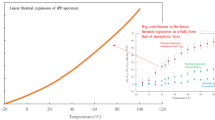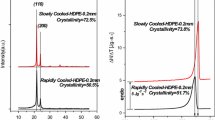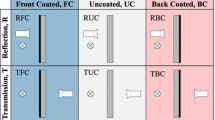Abstract
Infrared (IR) heating is widely used for thermoforming of thermoplastic polymers. The key benefit of radiation heating is that a significant amount of the radiative energy penetrates into the polymers thanks to their semi-transparency. For the case of heating unfilled semi-crystalline polymers, the relation between their microcrystalline structure and optical properties is the key to develop a predictive IR-heating model as microcrystalline structure introduces an optically heterogeneous medium. In this study, a relation between the microcrystalline structure of a polyethylene (PE) and its effect on the thermo-optical properties was experimentally analyzed considering a two-step analysis. At very first step, the relation was analyzed considering samples with identical thicknesses and different morphologies, characterized here in terms of degree of crystallinity (Xc (%)). Using Fourier Transform Infrared (FT-IR) spectroscopy and integrating sphere, optical characteristics of the PE samples were analyzed in near-infrared (NIR) and middle-infrared (MIR) spectral ranges. The analyses showed that a slight variation in Xc (%) has a great effect on the optical characteristics of PE, particularly the transmission characteristics in NIR range. The wavelength-dependent effect of Xc (%) on the transmission behaviors opened a discussion about the fact that the microcrystalline structures -in particular spherulites or their substructures such as lamellae- are responsible for optical scattering. Using the optical properties obtained from the two-step experimental analyses, two different thermo-optical properties were calculated, namely extinction and absorption coefficients, and used as a numerical input for the parametric numerical studies. The numerical studies were performed using an in-house developed radiation heat transfer algorithm -RAYHEAT-. Both the experimental and numerical analyses demonstrated the importance of the optical scattering regarding the identification of thermo-optical properties, used as a numerical input for radiation heat transfer models.










Similar content being viewed by others
References
Burkhardt G, Hüsgen U, Kalwa M, Pötsch G, Schwenzer C (2011) Plastics processing, 1. Processing of thermoplastics. In: Elvers B (ed) Ullmann’s encyclopedia of industrial chemistry. Wiley-VCH Verlag GmbH & Co. KGaA, Germany, pp 367–404
Becker F, Potente H (2002) A step towards understanding the heating phase of laser transmission welding in polymers. Polym Eng Sci 42:365–374
Schmidt F (2003) Modelling of infrared heating of thermoplastic sheet used in thermoforming process. J Mater Process Technol 143-144:225–231. https://doi.org/10.1016/S0924-0136(03)00291-7
Monteix S, Schmidt F, Le Maoult Y et al (2001) Experimental study and numerical simulation of preform or sheet exposed to infrared radiative heating. J Mater Process Technol 119:90–97
Cosson B, Schmidt F, Le Maoult Y, Bordival M (2011) Infrared heating stage simulation of semi-transparent media (PET) using ray tracing method. Int J Mater Form 4:1–10. https://doi.org/10.1007/s12289-010-0985-8
Geiger M, Frick T, Schmidt M (2009) Optical properties of plastics and their role for the modelling of the laser transmission welding process. Prod Eng 3:49–55. https://doi.org/10.1007/s11740-008-0141-1
Mayboudi LS (2008) Heat Transfer Modelling and Thermal Imaging Experiments in Laser Transmission Welding of Thermoplastics. Ph.D. thesis, Queen’s University
Asséko ACA, Cosson B, Schmidt F et al (2015) Laser transmission welding of composites-part a: Thermo-physical and optical characterization of materials. Infrared Phys Technol 72:293–299. https://doi.org/10.1016/j.infrared.2015.02.004
Chen M, Zak G, Bates PJ (2011) Effect of carbon black on light transmission in laser welding of thermoplastics. J Mater Process Technol 211:43–47. https://doi.org/10.1016/j.jmatprotec.2010.08.017
Klein R (2011) Chapter 1- material properties of plastics. In: Laser welding of plastics: materials. Processes and Industrial Applications. Wiley-VCH Verlag GmbH & Co. KGaA, Weinheim, Germany, pp 3–69
Ilie M, Kneip J-C, Matteï S et al (2007) Laser beam scattering effects in non-absorbent inhomogenous polymers. Opt Lasers Eng 45:405–412. https://doi.org/10.1016/j.optlaseng.2006.07.004
Hakoume D, Dombrovsky LA, Delaunay D, Rousseau B (2014) Spectroscopic diagnostics of morphological changes arising in thermal processing of polypropylene. Appl Opt 53:2702. https://doi.org/10.1364/AO.53.002702
Hohmann M, Devrient M, Klämpfl F et al (2014) Simulation of light propagation within glass fiber filled thermoplastics for laser transmission welding. Phys Procedia 56:1198–1207. https://doi.org/10.1016/j.phpro.2014.08.035
Stokes-Griffin CM, Compston P (2015) Optical characterisation and modelling for oblique near-infrared laser heating of carbon fibre reinforced thermoplastic composites. Opt Lasers Eng 72:1–11. https://doi.org/10.1016/j.optlaseng.2015.03.016
Lebaudy P, Saiter JM, Grenet J, Vautier C (1992) Temperature distribution in poly (ethylene terephthalate) plate undergoing heat treatment. Diffusion influence: 1. Theoretical approach. Polymer 33:1887–1892. https://doi.org/10.1016/0032-3861(92)90488-I
Denis A, Dargent E, Lebaudy PH et al (1996) Dependence on the spectral scattering coefficient on crystallinity into semicrystalline polyester. J Appl Polym Sci 62:1211–1218. https://doi.org/10.1002/(SICI)1097-4628(19961121)62:8<1211::AID-APP11>3.0.CO;2-A
Hakoume D, Dombrovsky LA, Delaunay D, Rousseau B (2014) Effect of Processing Temperature on Radiative Properties of Polypropylene and Heat Transfer in the Pure and Glassfibre Reinforced Polymer. https://doi.org/10.1615/IHTC15.rad.008207
Boztepe S, Thiam A, de Almeida O, Le Maoult Y, Schmidt F (2016) Experimental analysis on the coupled effect between thermo-optical properties and microstructure of semi-crystalline thermoplastics. p 020006. https://doi.org/10.1063/1.4963410
Reiter G, Strobl GR (2007) Progress in understanding of polymer crystallization. Springer, Berlin; New York
Zalewski EF (1995) Radiometry and photometry. Handb Opt 2:24–21
Apetz R, van Bruggen MPB (2003) Transparent alumina: a light-scattering model. J Am Ceram Soc 86:480–486. https://doi.org/10.1111/j.1151-2916.2003.tb03325.x
Peelen JGJ, Metselaar R (1974) Light scattering by pores in polycrystalline materials: transmission properties of alumina. J Appl Phys 45:216–220. https://doi.org/10.1063/1.1662961
Howell JR, Menguc MP, Siegel R (2010) Thermal radiation heat transfer, 5th edition, 5 edition. CRC Press, Boca Raton
Kessel J (1986) Transmittance measurements in the integrating sphere. Appl Opt 25:2752. https://doi.org/10.1364/AO.25.002752
Manara J, Arduini-Schuster M, Hanssen L (2009) Integrating sphere reflectance and transmittance intercomparison measurements for evaluating the accuracies of the achieved results. High Temp–High Press 38:259–276
The role of microcrystalline structure on the temperature-dependent thermo-optical properties of semi-crystalline thermoplastics and non-invasive temperature measurements (2017), 25ème Congrès Français de Thermique, Marseille - France
Genna S, Leone C, Tagliaferri V (2017) Characterization of laser beam transmission through a high density polyethylene (HDPE) plate. Opt Laser Technol 88:61–67. https://doi.org/10.1016/j.optlastec.2016.08.010
Viscarra Rossel RA, Walvoort DJJ, McBratney AB et al (2006) Visible, near infrared, mid infrared or combined diffuse reflectance spectroscopy for simultaneous assessment of various soil properties. Geoderma 131:59–75. https://doi.org/10.1016/j.geoderma.2005.03.007
Sasic S, Ozaki Y (2011) Raman, infrared, and near-infrared chemical imaging. John Wiley & Sons, Hoboken
Wriedt T (2012) Mie theory: a review. In: Hergert W, Wriedt T (eds) Mie theory. Springer Berlin Heidelberg, Berlin, Heidelberg, pp 53–71
Heck B, Kawai T, Strobl G (2006) Time dependent light attenuation measurements used in studies of the kinetics of polymer crystallization. Polymer 47:5538–5543. https://doi.org/10.1016/j.polymer.2005.11.098
Modest MF (2003) Radiative Heat Transfer, Second Edition, 2 edition. Academic Press, Amsterdam; Boston
Boglea AL, Roesner A, Russek UA (2011) Laser beam welding of thermoplastics. In: Poprawe R (ed) Tailored light 2. Springer Berlin Heidelberg, Berlin, Heidelberg, pp 284–307
Coelho JMP, Abreu MA, Carvalho Rodrigues F (2004) Methodologies for determining thermoplastic films optical parameters at 10.6 μm laser wavelength. Polym Test 23:307–312. https://doi.org/10.1016/j.polymertesting.2003.07.001
Bendada A, Cole K, Lamontagne M, Simard Y (2003) A hollow waveguide infrared thermometer for polymer temperature measurement during injection moulding. J opt. Pure Appl Opt 5:464
Gulmine J, Janissek P, Heise H, Akcelrud L (2002) Polyethylene characterization by FTIR. Polym Test 21:557–563. https://doi.org/10.1016/S0142-9418(01)00124-6
DeWitt DP, Nutter GD (1988) Theory and practice of radiation thermometry. John Wiley & Sons, Hoboken
Jensen K, Ripoll J, Wray A et al (2007) On various modeling approaches to radiative heat transfer in pool fires. Combust Flame 148:263–279. https://doi.org/10.1016/j.combustflame.2006.09.008
Bordival M, Schmidt FM, Le Maoult Y et al (2010) A ray tracing method to simulate the infrared heating of semi-transparent thermoplastics. Int J Mater Form 3:809–812. https://doi.org/10.1007/s12289-010-0893-y
Biron M (2012) Thermoplastics and thermoplastic composites. William Andrew Publishing, Norwich
Faghri A, Zhang Y, Howell JR (2010) Advanced heat and mass transfer. Global Digital Press, Columbia, USA
Acknowledgements
The authors declare that they have no conflict of interest.
Author information
Authors and Affiliations
Corresponding author
Rights and permissions
About this article
Cite this article
Boztepe, S., Gilblas, R., de Almeida, O. et al. The role of microcrystalline structure on optical scattering characteristics of semi-crystalline thermoplastics and the accuracy of numerical input for IR-heating modeling. Int J Mater Form 11, 717–727 (2018). https://doi.org/10.1007/s12289-017-1386-z
Received:
Accepted:
Published:
Issue Date:
DOI: https://doi.org/10.1007/s12289-017-1386-z




